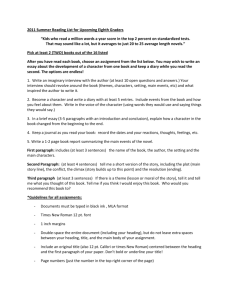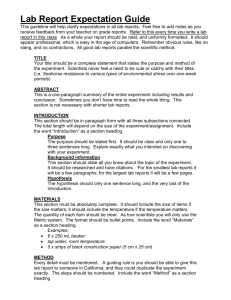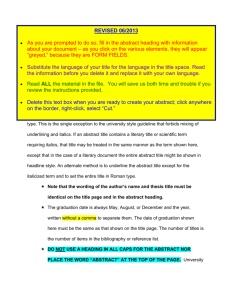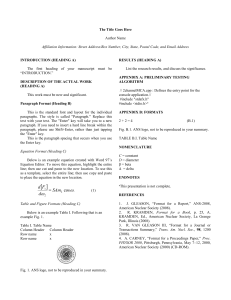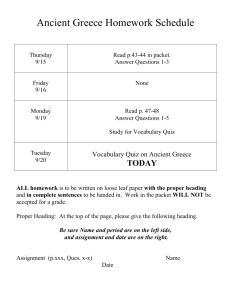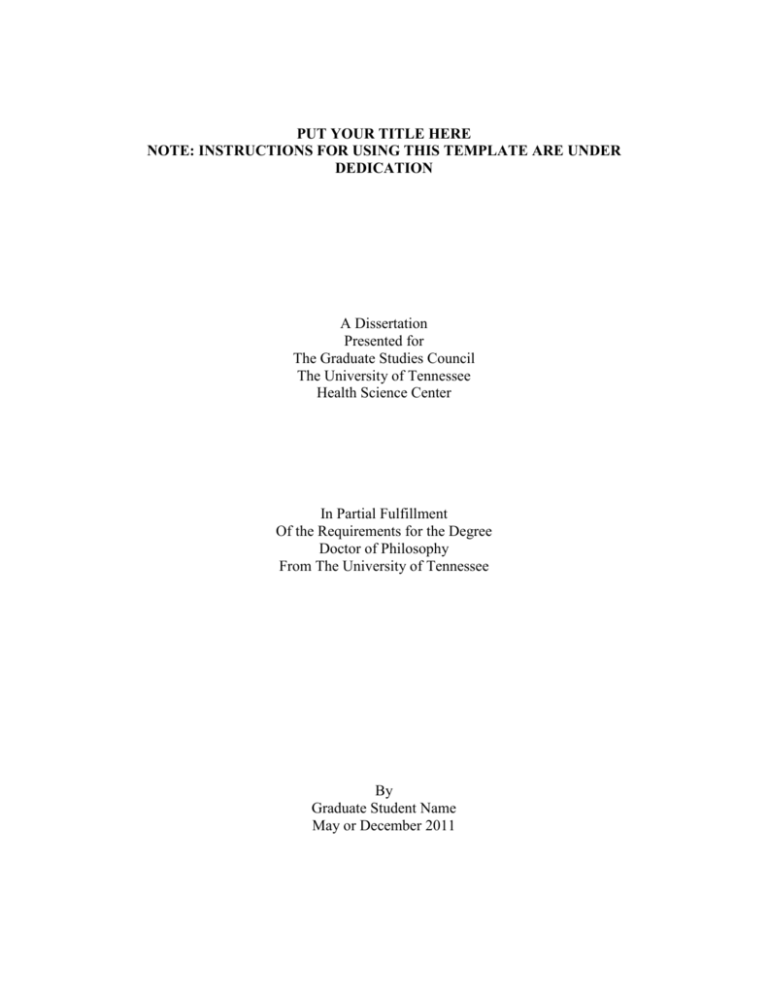
PUT YOUR TITLE HERE
NOTE: INSTRUCTIONS FOR USING THIS TEMPLATE ARE UNDER
DEDICATION
A Dissertation
Presented for
The Graduate Studies Council
The University of Tennessee
Health Science Center
In Partial Fulfillment
Of the Requirements for the Degree
Doctor of Philosophy
From The University of Tennessee
By
Graduate Student Name
May or December 2011
Copyright © 2011 by Graduate Student Name.
All rights reserved.
See special wording in Guide if you have a copyright release to use previously published
material.
ii
DEDICATION
This template provides the basic structure for your ET/D, including standard
section titles (e.g., Dedication, Table of Contents, Vita, etc.), chapter title styling
(Heading 1) and four levels of subdivisions (Headings 2-5). Use these section heads
exactly as they are set up here, except add the descriptive portion of your chapter titles, if
they differ from what’s given here; don’t change “CHAPTER #” as this auto generates
table/figure numbers for each chapter.
If you are pouring in an already created ET/D, DO NOT bring in the Title page,
Table of Contents (TOC), List of Tables (LOT), and List of Figures (LOF) in the front
matter. You can copy in the blocks of text on the Title page.
Note for Title page: This is set up for a Doctor of Philosophy; change
appropriately for other degrees. Templates are available on the ET/D web page
(http://www.uthsc.edu/grad/TandD/index.php?page=TandDGuidesForms#Guide); see
also the Appendix to the Guide there for sample pages.
The Title page, Table of Contents (TOC), List of Tables (LOT), and List of
Figures (LOF) have correct styling preset in this template; do not change it. Your title on
the Title page and all front- and back-matter titles as well as chapter titles are locked for
all caps, even if you type lowercase, to help ensure correct styling of these areas; do not
change them.
To auto update the Table of Contents, List of Tables, and List of Figures after you
have styled your headings and table/figure captions in the body, right click the top line on
the appropriate page. Choose Update Field, and update the entire table to ensure that all
titles and page numbers are correct. When proofing, print these front matter sections and
check against the entire body; if you failed to style a heading it won’t appear.
NOTE regarding the TOC: If you have an asterisk after a chapter title that points
the reader to a footnote for previously published material, you must manually delete that
asterisk if it appears in the TOC. You can also change styling of the * to Normal in the
body.
Detailed instructions for each section as well as tables and figures are in the body,
beginning with Chapter 1. Look over the entire template, reading the instructions, before
you begin, to get a good idea of what’s available here.
Be sure you delete all the additional text in the template as you use it. Before you
begin working, you may wish to save a copy of the original template for reference.
iii
ACKNOWLEDGEMENTS
Start your acknowledgements here, leaving 1 blank space between paragraphs.
Use the Tab key (not the space bar) to indent paragraphs in this document.
iv
ABSTRACT
Start the text of your abstract here. Leave 1 blank space between all paragraphs in
the ET/D.
Use the Tab key (not the space bar) to indent paragraphs in this document.
v
PREFACE
Start your preface statement here, if you have one, or delete this page.
NOTE: Start the Table of Contents exactly where it starts in this template to
achieve the visual look of 2 blank single spaces above it even though there is only 1 hard
return (extra space is auto added above each chapter title).
vi
TABLE OF CONTENTS
CHAPTER 1. INTRODUCTION .....................................................................................1
Heading 2 Is the First Subdivision in a Chapter ..............................................................1
Heading 2 .........................................................................................................................1
Heading 3 .....................................................................................................................1
Heading 3 .....................................................................................................................1
Heading 2 .........................................................................................................................2
Heading 3 .....................................................................................................................3
Heading 3 .....................................................................................................................3
Heading 2 .........................................................................................................................3
Heading 2 .......................................................................................................................11
CHAPTER 2. YOUR TITLE GOES HERE; USUALLY IT IS LITERATURE
REVIEW ...........................................................................................................................12
CHAPTER 3. YOUR TITLE GOES HERE; OFTEN IT IS METHODOLOGY* ...13
Study Design ..................................................................................................................13
Sample Title ...................................................................................................................14
CHAPTER 4. TYPICALLY THIS IS CALLED RESULTS .......................................15
Staff Outcomes ..............................................................................................................15
CHAPTER 5. TYPICALLY THIS IS CALLED DISCUSSION .................................18
CHAPTER 6. ADDING A CHAPTER ..........................................................................19
LIST OF REFERENCES ................................................................................................20
APPENDIX A. TITLE GOES HERE ............................................................................21
APPENDIX B. TITLE GOES HERE.............................................................................23
APPENDIX C. TITLE GOES HERE ............................................................................24
VITA..................................................................................................................................25
vii
LIST OF TABLES
Table 1-1.
Title of your table goes at top line of type ......................................................6
Table 1-2.
Title of table starts here.................................................................................11
Table 4-1.
Characteristics of staff sample (N = 49) .......................................................15
Table 4-2.
Comparison of age at diagnosis for all cancer diagnoses and for acute
lymphoblastic leukemia in Guatemala and Honduras ..................................16
viii
LIST OF FIGURES
Figure 1-1. Sample figure to show that the title goes 2 visual line spaces under the
figure ..............................................................................................................4
Figure 1-2. Conceptual model based on logic model theory .............................................5
Figure 1-3. Title of figure for a legend page goes here .....................................................8
ix
LIST OF ABBREVIATIONS
LOA
List of Abbreviations
NOTES:
Give abbreviations at left in alpha order and definitions at right.
Include items beginning with a Greek letter at the beginning of the list.
Include items with numbers in numerical order at the end of the list.
Use capitalization consistently.
CAUTION: If you delete this page, be careful not to delete the Section Break
immediately below this comment, since it signals for page numbering on Chap.1 to
start at page 1.
x
CHAPTER 1.
INTRODUCTION
Heading 2 Is the First Subdivision in a Chapter
Start paragraph here. Note that 1 space is left after free-standing heads before
starting the text. Use initial caps or all caps when typing all Heading 2 titles.
When typing chapter titles, only add the descriptive title after the chapter number.
“Chapter 1” is built into the template; don’t mess with it as it is auto numbered, and that
number feeds into the auto numbering of tables and figures.
Leave 1 space between all paragraphs. Leave 2 spaces above all Heading 2 and 3
levels; leave 1 or 2 consistently before all additional headings. This template leaves 2
spaces above all headings after chapter titles.
Heading 2
The front matter, back matter, and chapter titles as well as subdivision heads
already have the correct style on the Home tab applied (Heading 1 for chapter titles). To
create additional subdivisions within a chapter, click a head whose level you wish to
replicate and check styles to know the name of the style to use. In the Styles gallery, use
the arrow at bottom right corner to view all styles; the list will appear at the right of your
document.
Heading 3
Use initial caps or sentence caps when typing all Heading 3 titles.
On the Insert tab, the galleries include items that are designed to coordinate with
the overall look of your document. You can use these galleries to insert tables, lists, and
other document building blocks. When you create pictures, charts, or diagrams, they also
coordinate with your current document look.
You can easily change the formatting of selected text by choosing a look for that
text from the Font gallery on the Home tab: e.g., bold, italic,.or superscript. Leave styling
of all section titles and headings as designated in this template, however.
Heading 3
There should be no punctuation after free-standing heads (Headings 2-4) unless a
question mark is needed. There must be at least two subheadings at each level, as there
are two Heading 3s under Heading 2 here.
1
Heading 4. Text after this run-in head starts here. If there are several sentences,
they will auto wrap back to the left margin, like this. Note that there is a period after this
head. There should be no punctuation after any free-standing head (unless a question
mark is needed).
Heading 4. Text after this run-in head starts here. If there are several sentences,
they will auto wrap back to the left margin, like this.
Note that at any level, you must have a minimum of 2 subdivisions of any topic.
Check for this after you generate the Table of Contents.
Heading 5. Text after this run-in head starts here. If there are several sentences,
they will auto wrap back to the left margin, like this.
The next paragraph begins here.
Heading 5. Text after this run-in head starts here. If there are several sentences,
they will auto wrap back to the left margin, like this.
The next paragraph begins here.
The next paragraph begins here.
The next paragraph begins here.
The next paragraph begins here.
The next paragraph begins here.
The next paragraph begins here.
The next paragraph begins here.
The next paragraph begins here.
Heading 2
Start paragraph here. If a head falls at the bottom of a page, as here, it must be
followed by 2 lines of text. Otherwise, insert a page break to force it to the next page.
2
Heading 3
Bulleted list begins here with first item. Use this List Paragraph styling under any
heading level. If the list needs to be numbered, simply change the bullet to “1)”
(or other appropriate choice). The tabbed indent is set to accommodate a two-digit
number.
Item 2
Item 3
Heading 3
Text begins here. This text illustrates a reference to the first figure like this
(Figure 1-1). Note that the period goes after the end paren. If you use superscript
numbers, place the period immediately after the last word; do not leave a space before or
between superscript numbers.
If the figure and its title/notes are less than half a page tall and the initial callout
comes in the top half of the page, the figure can appear at the bottom of the page,
preceded by 2 blank spaces. Fill all the space above it with text.
If the figure and its title/notes are more than half a page tall, they must go on the
next page. Here is the reference to Figure 1-2. Tables and figures follow on succeeding
pages in the order in which they are called out. When possible, put two figures/tables per
page.
The initial reference to the first table occurs here like this (Table 1-1). The next
figure reference is here (Figure 1-3); note that the figure needs a legend page preceding it
because the figure and its title and notes cannot get on one page. If your figure will be on
the next page, fill this page with text clear to the bottom line, even if a sentence must split
between this page and the page immediately after the last table/figure presented.
Heading 2
Start paragraph here. Note that if a head falls at the bottom of a page, it must be
followed by 2 lines of text. Otherwise, put a page break to force it to the next page.
Because a figure page, table page, and then a legend page and figure will come next, the
following heading will be on the page after the last table/figure at the top line of type.
(This text is artificially added to show that you need to fill this page completely with text.
This text is artificially added to show that you need to fill this page completely with text.
This text is artificially added to show that you need to fill this page completely with text.
This text is artificially added to show that you need to fill this page completely with text )
3
Figure 1-1.
figure
Sample figure to show that the title goes 2 visual line spaces under the
Only insert a figure, not the caption; flatten images in your imaging program before
inserting. To add the caption for your figure, right click on the figure to select it; choose
Insert Caption. Choose—Label: Select Figure. Position. Choose insert the caption below
the selected item. Remove check from Exclude Label from Caption if not already
deselected. Numbering. Choose numbering options for the label. Format 1,2,3. Check
include chapter number; chapter starts with styles heading 1; use separator hyphen, click
OK.
Insert 2 single spaces above the figure number (this should visually look like 2 spaces).
After the figure number add a period; then use a tab instead of spaces. Type your figure
title with sentence caps. If you copy and paste your title you may need to delete any extra
spaces before it and insert the tab after the figure number. All figures should start at the
top line of type and be centered horizontally. Crop figures with as little extra white space
outside the figure as possible for correct centering.
4
Figure 1-2.
Conceptual model based on logic model theory
If you have notes or a legend, start here. Order and style them consistently—e.g., legend
information, then definitions of abbreviations, then general notes. Style references to
panels consistently.
5
Table 1-1.
Title of your table goes at top line of type
Column 1 head
Guatemalan nursing pro
gram
Pediatric oncology nurse
educator
Staff nurse
Professional nurse
Employed full time
Continuing education hours
Chemotherapy competency
Central venous line care
competency
Pediatric oncology education
course for newly hired nurses
Column 2 head
A program developed at St. Jude’s partner site in
Guatemala City, Guatemala, to meet critical nursing
needs determined by the JCI nursing assessment. The
primary focus of the program was improving nursing
education and staffing. A secondary focus was
improving all nursing quality standards.
A professional nurse dedicated full time to
implementing a pediatric oncology education
program,, providing continuing education, teaching
courses in chemotherapy administration and central
venous line care skills, improving quality standards
relevant to nursing, and serving as the IOP nursing
liaison.
A full time professional nurse who had worked for a
minimum of six months at St. Jude’s partner site at the
National Unit of Pediatric Oncology in Guatemala
City, Guatemala and was not in a management
position.
Graduation from a school of nursing (diploma or
university degree) as documented by the hospital’s
human resources department.
Working ≥ 30 hours per week.
Documented attendance at an educational class.
Education was documented in the nurse’s education
record and included title of class, length of time, and
presenter.
Documented chemotherapy course completion in the
nurse’s education record. Documentation included
course title, date, hours of course, presenter, and
course evaluation score. A course evaluation score of
≥70% was required for competency.
Documented central venous line care course
completion in the nurse’s education record.
Documentation included course title, date, hours of
course, presenter, and course evaluation score. A
course evaluation score of ≥ 70% was required for
competency.
5 consecutive days of documented theoretical
presentations and 5 consecutive days of documented
clinical experience with a preceptor. An evaluation
score of ≥ 70% was required for successful completion
of the course.
6
Table 1-1.
(Continued)
Column 1 head
Abandonment of treatment
Cancer
Column 2 head
4 consecutive weeks of missed appointments during
active cancer treatment.
Patients diagnosed with acute lymphoblastic
leukemia, acute myelogenous leukemia,
neuroblastoma, hepatoblastoma, retinoblastoma,
rhabdomyosarcoma, Hodgkin’s disease, NonHodgkin’s lymphoma, osteosarcoma, Ewing’s
sarcoma, Wilms tumor, and germ cell tumor
NOTE: In this table template, there is no space over or under the column heads and none
after the column head closing line. There is also no space between the last line of the
table data and the table closing line. Be consistent in using sentence caps or initial caps
for column heads and text within the table. Table notes go after the table, preceded by 1
single blank space, as in this sample.
The 3 horizontal lines you see in this table template are the only lines that should be
visible; there should be no vertical lines. The lines should be black and of a light weight
(these are ½ pt). Spanner heads should be underlined to show all columns under them that
are affected.
To add additional tables, place a return at the top line on a new page; copy and paste an
already created table, or create a table using the Insert function; choose table and style
appropriately. To autogenerate the caption for your table, mouse over the table to get a
crosshair (+) at the top left of the table body (by the colum heads) and choose choose
Insert Caption—It will auto add the next table #; label Table; choose Position Above
selected item; remove check from Exclude Label from Caption. Click OK. After the table
number, add a period; then insert a tab. Type the title of your table using sentence caps.
After creating the table, go back and delete the return you added at the top of the page
since that simply helped you add the table caption and leave 1 blank space after it before
the table opening line.
NOTE: If you use tabs to create a table, you must right click on the table to select it and
go up to References. Choose Insert Caption and follow the instructions in the last
paragraph.
7
Figure 1-3.
Title of figure for a legend page goes here
Notes for figure go here, left justified. If you have asterisks, for example, that you must
define, handle them like this, after the note:
* Start your definition here.
** Start second definition here. Note that all abbreviations must be defined for each
figure, even if they are repeated on several figures, and even if they are defined in text.
NOTES: This page is an example of a legend page, which is used when a figure and its
title and notes won’t fit on one page. The next page is considered the first page of the
actual figure and hence is not a continued page. If the figure itself is on two pages, the
actual second page of the figure is be treated as a continued page.
Only the figure title and notes go on this page; start at the top line of type.
The figure number on this page feeds to the List of Figures.
8
Imagine figure fills the page.
Your figure needs to start at the top line of type on the page after the legend page. Be sure
to crop figures so you leave as little extra space around them as possible. Center figures
horizontally.
For illustration purposes, imagine that this figure fills this page and has panels that
continue to the next page.
9
Figure 1-3.
(Continued)
Pretend that the figure is continued on this page. Your continued figure (like all figures
and tables that fill a page) should start at the top line of type. Leave 2 blank visual spaces
after the figure end before putting the figure number and continued statement; note that
this line is styled Normal.
For continued table pages, the table number goes at the top line of type, followed by the
continued statement after the tab.
10
Heading 2
The text starts here. Note that the heading or text that follows a figure/table page
starts at the top line of type.
If a reference to a table/figure that is small occurs at the top half of a page, as
here, you can put the figure/table at the very bottom of the page, but fill the rest of the
page with type---leaving 2 line spaces (but only 2) blank above the figure/table (Table 12).
If they are referred to in text, equations are numbered consecutively throughout
the text (and appendix, if appropriate) using the format in the following example. The
equation number is styled like table/figure numbers.
R1 cos 1 R2 cos 2 R3 cos 3 R4 cos 4 0
(Eq. 1-1)
Number equations by chapter (e.g., 3-2), since tables and figures are numbered by
chapter in this template. Number equations only if referred to in the text; each equation in
a series of equations does not need to be numbered. Center the equation itself, leaving 1
blank space over and under it.
Pretend the rest of this page is filled with type.
Pretend the rest of this page is filled with type.
Pretend the rest of this page is filled with type.
Pretend the rest of this page is filled with type.
Pretend the rest of this page is filled with type.
Pretend the rest of this page is filled with type.
Pretend the rest of this page is filled with type.
Table 1-2.
Title of table starts here
Characteristics
Age (yrs)
Weight (kg)
RBMI (kg/m2)
Gender (%) female
Mean (SD)
12.9 (2.9)
92.2 (28.4)
195.5 (42.4)
70.0
RBMI – Relative Body Mass Index
11
CHAPTER 2.
YOUR TITLE GOES HERE; USUALLY IT IS LITERATURE
REVIEW
Text or a Heading 2 starts here.
12
CHAPTER 3.
YOUR TITLE GOES HERE; OFTEN IT IS METHODOLOGY*
This page shows how to handle footnoting previously published material. It
contains sample text so you can see now the page is filled above the footnote at bottom.
The asterisk after the chapter title and use of a corresponding footnote is for previously
published material. Be sure that your styling for the chapter title as Heading 1 ends before
the asterisk (*) so that it doesn’t carry over to the Table of Contents.
Study Design
The purpose of the study was to evaluate the Guatemalan Nursing Program’s
(GNP) impact on staff, organizational, and clinical outcomes. Staff and organizational
outcomes were evaluated using a before and after one group design often used in program
evaluation. The clinical outcomes were evaluated using a control site comparison but no
randomization and was therefore a quasi-experimental design.
Variables analyzed included staff variables of a) continuing education hours, b)
chemotherapy competency, c) central venous line care competency, and d) pediatric
oncology nursing education course completion, organizational variables of a) JCI
standards, and b) patient to nurse ratio, and clinical variables of a) event free survival
(EFS), and b) abandonment of treatment. The sample used to measure staff variables
consisted of 49 professional nurses employed full time at the Guatemalan site and not in a
management position. The sample used to measure event free survival and abandonment
consisted of all patients entered in the Pediatric Oncology Networked Data Base (POND)
diagnosed with cancer from January 1, 2004 to October 1, 2008. For analysis, the sample
was further divided into two groups: pre program group and post program group.
The principal investigator traveled to the intervention site in July of 2009 to
collect data to evaluate the staff and organizational outcomes. The education charts of all
professional nurses who qualified for the study were reviewed and results documented on
a data collection assessment form. The nursing quality assessment was used to evaluate
the organizational outcomes. The same process used to conduct the initial nursing
assessment completed in April of 2006 was used to conduct the post intervention
assessment.
Fill this page with text, leaving only 2 blank line spaces before starting the
footnote. Note the wording of the permission statement. Footnote for acknowledgement
of previously published material goes here. Note wording: Citation wording and styling
should match the LOR entry.
* Adapted with permission. Day, S. W., Dycus, P. M., Chismark, E. A., & McKeon, L.
(2008). Quality assessment of pediatric oncology nursing care in a Central American
country: findings, recommendations, and preliminary outcomes. Pediatr Nurs, 34(5), 367373.
13
Sample Title
NOTE: This title was forced to this page by inserting a page break because it and
2 lines of text would not fit at the bottom of the previous page above the permission
statement.
When you finish a chapter, insert a page break to go to the next chapter title.
14
CHAPTER 4.
TYPICALLY THIS IS CALLED RESULTS
This sample page with text illustrates a table correctly placed at the bottom of a
page since the initial callout appears in the top half of the page. If the initial callout for
this table had come in the bottom half of the page, it would have appeared at the top of
the next page.
Staff Outcomes
The sample consisted of 49 full time professional staff nurses. Staff nurse was
defined as a full time professional nurse (working ≥ 30 hours per week) who had worked
for a minimum of six months at St. Jude’s partner site at the National Unit of Pediatric
Oncology in Guatemala City, Guatemala and was not in a management position.
Professional nurse was defined as a graduate from a school of nursing (diploma or
university degree) as documented by the hospital’s department of human resources.
Forty-nine nurses met the defining criteria and all were included in the study. Their mean
length of employment at the partner site was 3.5 years (range 0.5 to 9.6). The sample was
predominately female (94%), and 48 (98%) had a nursing diploma, as opposed to a
university degree. Twenty -four nurses (51%) were hired pre GNP implementation
(before January 1, 2007), and 25 (49%) were hired post program implementation (on or
after January 1, 2007). Age was not included in the demographics for identity reasons.
Demographic characteristics of the staff sample are reported in Table 4-1.
NOTE: Continue adding text here until it fills the page to within 2 blank line spaces
above the Table 4.1, as is illustrated in this sentence (which is artificially long to illustrate
the point). Table 4-2 illustrates a landscape table. Note that you insert section break on
the page before it, and you end the section by inserting another section break. To make
the page landscape orientation, choose it under Page Layout – then Orientation, Ensure
that page number styling is continuous from previous section.
(This text is added artificially to show how the page should be filled with type. This text
is added artificially to show how the page should be filled with type.)
Table 4-1.
Characteristics of staff sample (N = 49)
Characteristics
Employment in years, mean (range)
Female, % (N)
Diploma
Hired pre GNP
Hired post GNP
15
Total
Sample
3.5 (0.5-9.6)
94% (46)
98% (48)
49% (24)
51% (25)
Table 4-2.
Comparison of age at diagnosis for all cancer diagnoses and for acute lymphoblastic leukemia in
Guatemala and Honduras
Age at Diagnosis (Yrs)
All Cancer Diagnoses
Total
Guatemala
Honduras
Acute Lymphoblastic
Leukemia
Total
Guatemala
Honduras
N
Min
5%
Quartile
1936
1145
791
0.00
0.00
0.08
0.92
0.83
1.42
923
513
410
0.00
0.00
0.08
1.92
1.50
2.08
Median
95%
Quartile
Max
6.54
6.33
6.92
15.58
15.33
16.08
7.00
6.92
7.08
15.58
15.33
16.00
16
Mean
SD
p-Value
23.58 7.35
19.17 7.11
23.58 7.69
4.64
4.56
4.74
0.0092
17.83 7.76
17.83 7.62
17.83 7.94
4.42
4.25
4.62
0.4759
Text on this page following a table or figure page starts at top line of type. Note that this
line is not indented because the text from the previous paragraph (page before the table)
continued to this page. Be sure to insert a paragraph tab if the top line on such a page
starts a new paragraph.
17
CHAPTER 5.
TYPICALLY THIS IS CALLED DISCUSSION
Start text or a Heading 2 here.
18
CHAPTER 6.
ADDING A CHAPTER
To add additional chapters after this one, type descriptive title text for the wording
after the Chapter #, which is preset; do not change them. All chapter titles are Heading 1.
To add a page break before a new chapter title, next move the insertion cursor to the left
of the descriptive title (just after Chapter #) and add a page break
19
LIST OF REFERENCES
Aiken, L. H., Clarke, S. P., Cheung, R. B., Sloane, D. M., & Silber, J. H. (2003).
Educational levels of hospital nurses and surgical patient mortality. JAMA,
290(12), 1617-1623.
Aiken, L. H., Clarke, S. P., & Sloane, D. M. (2002). Hospital staffing, organization, and
quality of care: cross-national findings. Int J Qual Health Care, 14(1), 5-13.
The previous entries illustrate formatting if you are alphabetizing your LOR.
The next entries illustrate formatting if you are numbering your entries. The gap
space between the number and start of the entry accommodates a 3-digit number.
1.
Barr, R., Ribeiro, R., Agarwal, B., Masera, G., Hessling, P., & Magrath, I. (2006).
Pediatric oncology in countries with limited resources. In P. A. Pizzo & D. G.
Poplack (Eds.), Principles and practice of pediatric oncology. (pp. 1604-1616).
Philadelphia: Lippincott, Williams and Wilkins.
2.
Aiken, L. H., Clarke, S. P., Sloane, D. M., Lake, E. T., & Cheney, T. (2008).
Effects of hospital care environment on patient mortality and nurse outcomes. J
Nurs Adm, 38(5), 223-229.
3.
Carty, R. M., & White, J. F. (1996). Strategic planning for international nursing
education. Nurs Outlook, 44(2), 89-93.
4.
Bonilla, M., Rossell, N., Salaverria, C., Gupta, S., Barr, R., Sala, A., et al. (2009).
Prevalence and predictors of abandonment of therapy among children with cancer
in El Salvador. Int J Cancer, 125(9), 2144-2146.
20
APPENDIX A.
TITLE GOES HERE
Text or a Heading 2 starts here, as in chapters. If you have large, full-page
tables/figures in an appendix, you may have to put the appendix title, centered vertically
and horizontally, on a page by itself.
If you have text in the appendix with subdivisions, style them as you styled
subdivision heads in the body.
21
Start full-page tables/figures in an appendix on this line, centered, as this is.
22
APPENDIX B.
TITLE GOES HERE
If you have text or small tables/figures, start at this line if it/they can go on this
title page. If you need a separate appendix title page, use the Appendix A page that’s
centered both vertically and horizontally. Ensure that front-/back-matter titles and chapter
titles all start at the top line of type.
23
APPENDIX C.
TITLE GOES HERE
If you have text or small tables/figures, start at this line if it/they can go on this
title page. If you need a separate appendix title page, use the Appendix A page that’s
centered both vertically and horizontally. Ensure that front-/back-matter titles and chapter
titles all start at the top line of type.
To add appendixes after this one, we suggest you copy from the last paragraph
return at the bottom of Appendix B down to the second return under Appendix C in order
to be sure you’ve caught the styling for the entire Appendix C title; note that the next
alpha letter will be auto added by doing this.
24
VITA
Start your vita here.
25



